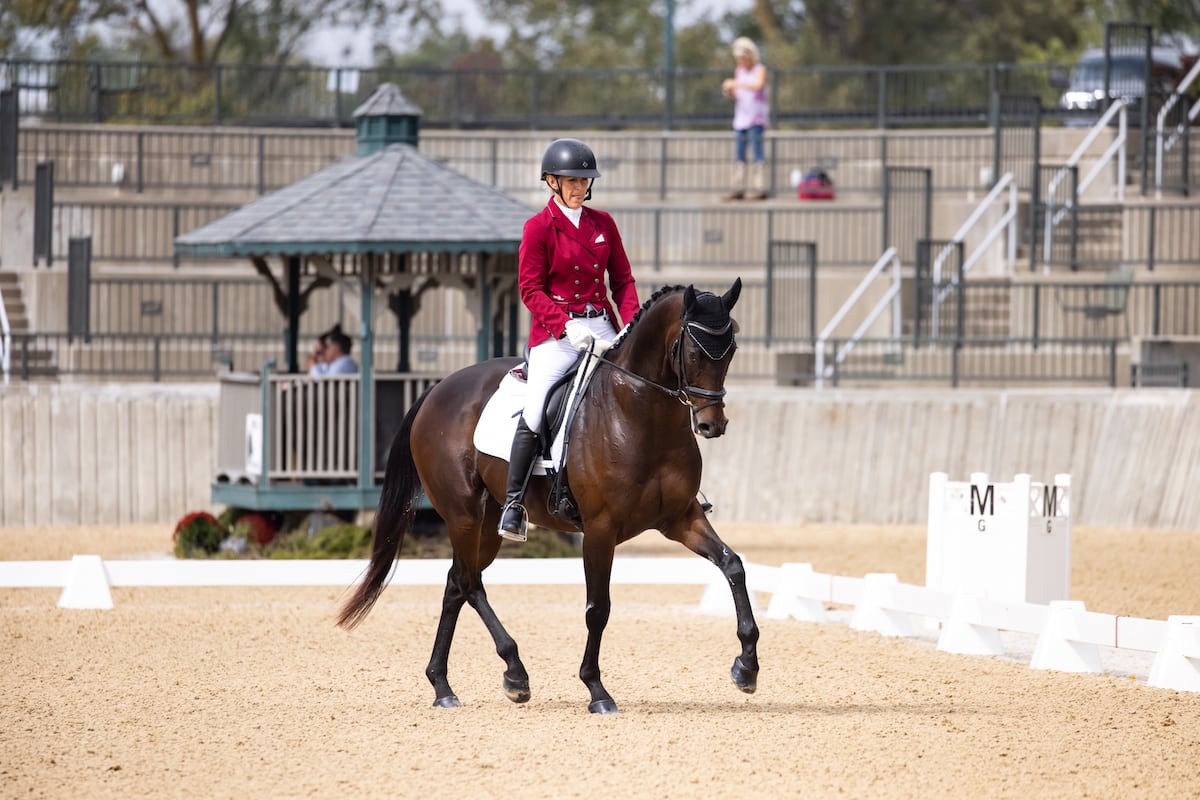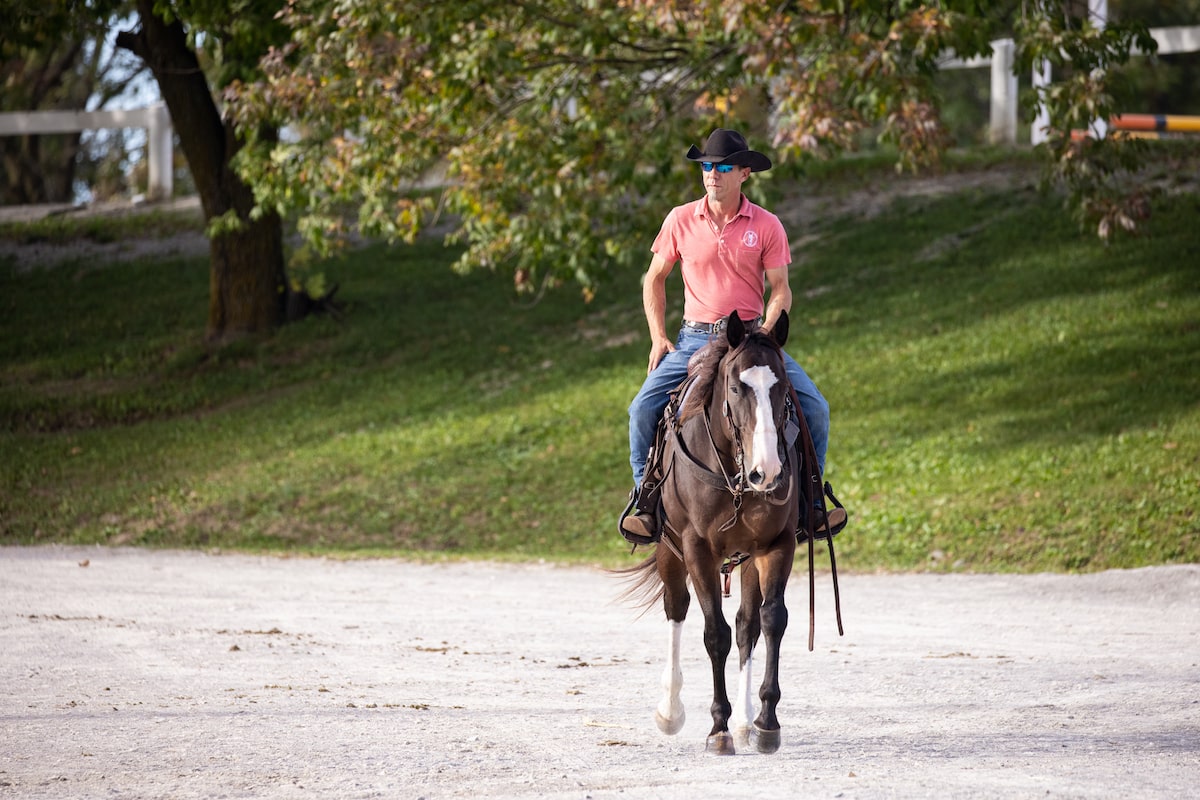Flatwork essentials for OTTBs that lay the foundation for any discipline

Atkins (pictured with 2020 Makeover graduate Imperative) uses flatwork basics to introduce OTTBs to a new way of going. Courtesy Bethany P Photography
A strong foundation on the flat can set any off-track Thoroughbred up for success whatever direction their second career takes them. While flatwork might not be your favorite part of retraining, it doesn’t have to be something you and your horse must suffer. It can be just as fun, challenging and enjoyable as any jumper course or competitive trail class.
Why is correct flatwork such a necessity? “It is the foundation of everything you do with the horse moving forward,” says Kimberly Clark, a United States Dressage Federation silver medalist (on her Thoroughbred, Mystical Harbor), jumper rider, retired exercise rider and founder of Thoroughbred Placement Resources, in Upper Marlboro, Maryland. “Taking the time to correctly develop the horse will give him confidence, and he will think it’s easy rather than struggling to do as you ask.”
Giving your horse the tools he needs on the flat can also help prevent training problems later. “Each jump or even pole on the ground upsets the balance of a horse,” says Clark. “He has two ways to regain balance: One is shifting his weight to the hind end, which is what we want. The other is to go faster. That’s the tool he came to earth with. It works great for racehorses because they go faster to maintain balance. (But) it’s unwanted behavior in many show and riding horses.”
Work the Walk
The most basic gait is often the most overlooked in a horse’s development. How many of us hop on, walk a lap or so and then get into the rest of the ride? Instead of taking the obligatory lap or two at the walk before trotting off for the “fun” stuff, use the walk to build basic fitness, gauge your horse’s physical and mental state that day and introduce concepts you’ll return to in faster gaits.
Early in the OTTB’s reschooling, keep it simple. Louise Atkins, dressage trainer, OTTB advocate and owner of Cobalt Stables, in Glenmoore, Pennsylvania, says this is the time to introduce the horse to a new way of going. “In the beginning I like to get a feel at the walk for their reaction to things,” she says. “I (exaggerate) my inside rein when turning to give them a guide to where they are going. I use a lot of outside rein and leg when they step out to keep the emphasis on straightness.”
Atkins also focuses on forward first. “I’m not worried about bend in the beginning, I just want to get them between my hands, coming out of their wither straight and get them forward in front of my leg,” she says. “I always use the mantra, ‘A horse has to learn to go forward before it can learn to come back.’ ”
When possible, spend 10 to 15 minutes warming up at the walk to get your horse prepared mentally and physically for the rest of the schooling session. Start with a forward walk, alternating gentle application of your leg as the horse lifts the corresponding hind leg, to encourage him to step more underneath himself. Keep even contact on each rein. Don’t worry about the position of the horse’s head but, rather, focus on feeling what the hind end is doing. Is the horse marching and pushing from behind, rather than pulling himself along on his forehand?
Incorporate basic school figures such as circles and serpentines, keeping them large on greener horses, and gradually making the figures smaller later in the horse’s schooling as he gains strength and education. With any change of direction, ensure the horse is truly straight in his body before asking for bend in the new direction.
Spending time in the walk each day is also an excellent way to introduce basic lateral work. “There’s nothing wrong with doing shallow zigzags around the farm or in the arena soon after starting them,” Clark says. “Racehorses are tight in their shoulders, and this is a good exercise for them in perpetuity, asking for more angle as they develop. It will loosen the shoulders and afford the rider more control of the shoulders for straightening the horse.”
Establishing this control and straightness at the walk is key for setting the horse up for success later in the trot and canter. Before focusing on lateral work itself, make sure the horse is forward and straight. “When I feel the horse is truly straight with no evasions, I will start shallow leg yields, just a couple of steps to begin with, building up to a full long side (of the arena),” says Atkins. “It’s important to encourage a correct sideways movement, so if the haunches are getting left behind, I’ll ride straight and then ask for sideways again.”
The walk work does not always have to be concentrated flatwork in the ring. “I like to power walk around the farm,” says Clark. “Power walking is a purposeful, loose, marching walk. It’s extremely useful in developing the topline of the horse, and it comes with a huge advantage: No pounding. It develops that difficult-to-build area of the back just behind the saddle.”
Introduce hacking outside the ring early in the OTTB’s retraining, and make it a regular part of his routine for both the physical and mental benefits. Spending the first several weeks just hacking will improve baseline fitness, help you bond with your horse and build his confidence. If you have access to rolling hills, consider gentle hill work an extra fitness bonus.

Walk work does not always have to be concentrated flatwork in the ring. Power walk around the farm to develop your horse’s topline in a low-impact way. Courtesy Bethany P Photography
Transitions as Tools
Horses naturally carry more weight on their forehand (65-70%) than their hind end. One of the goals of a correct flatwork routine is to teach the horse to shift some of his weight onto his hind legs and lighten his forehand. This shift allows the horse to push better off the ground to jumps, leads to more advanced collection in the dressage ring and makes for a handier barrel horse, a stronger trail horse and so much more. Transitions, both between gaits and within them (lengthening and shortening the stride), can be extremely useful for teaching the horse to shift his weight back.
Early on, teach your OTTB the meaning of your seat. Incorporate that into your use of transitions. “I will do a thousand walk-halt transitions using my seat and hands to teach them to respond to my seat, then slowly you can use less hand,” says Atkins. “When they start to get it, you can start doing it with trot-walk transitions. Don’t be afraid to do hundreds of transitions, it will only benefit you later.”
One other important aspect of correct transitions is the support of the rider’s leg. “Your legs should be (applied evenly) in the downward transitions to encourage the horse to stay up in a (contact) rather than collapse in a heap,” Atkins explains.
Combine these aspects to keep your flatwork sessions fresh and interesting. Ride that long walking warmup, and use it to get your horse loose and in front of your leg. Combine transitions into your school figures: Ride a serpentine at the trot and, on each straightaway, ride the downward transition to the walk while keeping the horse straight across the center of the arena, before asking for the new bend and upward transition to trot. Out hacking for conditioning work? Try adding leg yields to get the horse thinking and stepping under himself.
How do you know if you’re moving too fast or have missed something? “The horse will tell you by being uptight, upset or unwilling,” says Clark. “This is the sign to back up to a place the horse was comfortable so you can end the session as a success. Then regroup by trying to figure out what the horse needs, giving it to him and then moving forward.”
Flatwork is also an opportunity to branch out of your discipline and take lessons with a dressage trainer, if only temporarily. “Don’t be afraid to get help if you are struggling with something,” says Atkins. “Sometimes a set of eyes on the ground can tweak a little something that maybe you can’t see or feel.”
Take-Home Message
Whether you and your OTTB are at the start of your dressage career or are just looking to become stronger in any discipline, correct flatwork basics can help you establish a foundation for success. “Taking the time to give the horse the tools he will need to do the job you are training him for will give him confidence, keep him sounder mentally and physically and allow him to be a joy to ride,” says Clark.
This article was originally published in the Winter 2022 issue of Off-Track Thoroughbred Magazine, the only publication dedicated to the Thoroughbred ex-racehorse in second careers. Want four information-packed issues a year delivered to your door or your favorite digital device? Subscribe now!

